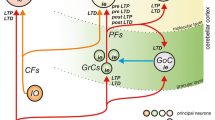Abstract.
According to modern views of the cerebellum in motor control, each cerebellar functional unit, or microzone, learns how to execute predictive and coordinative control, based on long-term depression of the granule cell-Purkinje cell synapses. In the present paper, in light of recent experimental and theoretical studies on synaptic elimination and cerebellar motor learning, a model of the formation of cerebellar microzones by climbing fiber synaptic elimination is proposed. It is shown that competition for an activity-dependent supply of neurotrophic factor can reproduce the spatio-temporal characteristics of climbing fiber synaptic elimination. It is further shown that when this elimination is accurate, motor coordination can be acquired in an arm reaching task. In view of the results of the present study, several predictions are proposed.
Similar content being viewed by others
Author information
Authors and Affiliations
Additional information
Received: 19 January 1998 / Accepted in revised form: 22 April 1998
Rights and permissions
About this article
Cite this article
Schweighofer, N. A model of activity-dependent formation of cerebellar microzones. Biol Cybern 79, 97–107 (1998). https://doi.org/10.1007/s004220050462
Issue Date:
DOI: https://doi.org/10.1007/s004220050462




